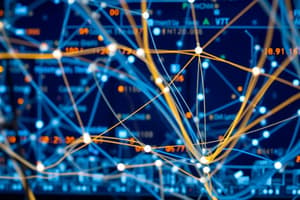Podcast
Questions and Answers
Apa yang dimaksud dengan jaringan LAN?
Apa yang dimaksud dengan jaringan LAN?
- Jaringan yang menghubungkan perangkat dalam area geografis yang besar
- Jaringan yang hanya bisa digunakan di dalam satu perangkat saja
- Jaringan yang menghubungkan perangkat dalam area geografis yang relatif kecil (correct)
- Jaringan yang memiliki protokol komunikasi yang tidak standar
Apa yang dimaksud dengan WAN?
Apa yang dimaksud dengan WAN?
- Jaringan yang tidak memiliki router
- Jaringan yang menghubungkan perangkat dalam area geografis yang besar (correct)
- Jaringan yang hanya bisa digunakan di dalam satu perangkat saja
- Jaringan lokal yang tidak membutuhkan koneksi internet
Apa yang menjadi tugas dari Internet Assigned Numbers Authority (IANA)?
Apa yang menjadi tugas dari Internet Assigned Numbers Authority (IANA)?
- Mengatur protokol komunikasi untuk jaringan global (correct)
- Menyediakan layanan aplikasi seperti email dan media sosial
- Memberikan alamat unik kepada jaringan-jaringan kecil
- Mengelola jaringan lokal di satu wilayah tertentu
Apa yang dimaksud dengan aplikasi layanan pada lapisan aplikasi internet?
Apa yang dimaksud dengan aplikasi layanan pada lapisan aplikasi internet?
Apa fungsi utama dari sebuah computer network?
Apa fungsi utama dari sebuah computer network?
Apa peran dari Network Interface Cards (NIC) dalam jaringan komputer?
Apa peran dari Network Interface Cards (NIC) dalam jaringan komputer?
Apa fungsi utama dari Router dalam jaringan komputer?
Apa fungsi utama dari Router dalam jaringan komputer?
Apa perbedaan utama antara Router dan Switch dalam jaringan komputer?
Apa perbedaan utama antara Router dan Switch dalam jaringan komputer?
Apa yang menjadi perbedaan utama antara cabling yang menggunakan metode nirkabel dan kabel?
Apa yang menjadi perbedaan utama antara cabling yang menggunakan metode nirkabel dan kabel?
Apa tujuan utama dari Protokol dalam jaringan komputer?
Apa tujuan utama dari Protokol dalam jaringan komputer?
Study Notes
Discovering Connection: Understanding Computer Networks and the Internet
Computer networks and the internet form an intricate web of connections, allowing information exchange across the globe at unprecedented speeds. To delve into this fascinating world, let's examine its fundamental principles and components.
Defining Computer Networks
A computer network is a collection of interconnected devices (such as computers, routers, switches, etc.) used for sharing data and resources. These systems communicate using standardized protocols, enabling seamless communication between various hardware and software platforms.
There exist two primary types of computer networks: LAN (Local Area Network) and WAN (Wide Area Network). A LAN connects devices within a relatively small geographical area, such as a school campus or office building, while a WAN extends over large distances—for example, linking different countries together through underwater cables.
Introducing the Internet
The internet represents a global network comprising countless smaller networks, each with unique addresses assigned by the Internet Assigned Numbers Authority, also known as IANA. This system allows any device connected to the internet to reach virtually every other device on it. The application layer services such as email, web browsers, social media, and video streaming are what we typically associate with our daily online activities.
Most people imagine the internet as one vast, homogeneous entity; however, this is largely untrue. In reality, many providers operate distinct autonomous systems (AS) that may have their own rules and routing policies. When you access a website from your home, your traffic might pass through several ASes before reaching its destination.
Key Components of Computer Networks
To establish connections among devices and enable efficient data transmission, certain elements play essential roles:
- Network Interface Cards (NIC): Also called Ethernet adapters, NICs serve as hardware bridges connecting PCs to local networks via cords.
- Router: Routers function as specialized nodes responsible for forwarding packets based on IP address information. They allow communication among multiple networks and decide which route provides optimal performance conditions.
- Switches: Similar to routers, but they only work inside the same network. Switches manage internal data flow, reducing collisions and improving overall efficiency.
- Cabling: To physically tie everything together, cabling employs wired or wireless methods to convey data signals among network components.
- Protocols: Various standards define the behavior of network equipment during transmissions. Examples of common protocols include TCP/IP, HTTP, and FTP.
Understanding these concepts offers insight into how computer networks facilitate collaboration and communication, ultimately shaping the future of human interaction. As technology progresses, expect even more profound advancements to emerge, driving innovation in fields like telemedicine, distance learning, cloud computing, and others.
Studying That Suits You
Use AI to generate personalized quizzes and flashcards to suit your learning preferences.
Description
Menjelajahi prinsip dasar dan komponen-komponen penting dalam jaringan komputer dan internet, termasuk definisi jaringan komputer, pengenalan internet, serta komponen kunci yang mendukung koneksi dan transmisi data yang efisien.




